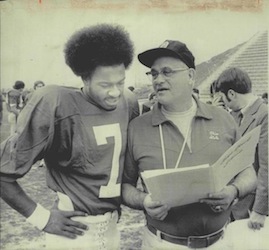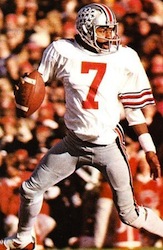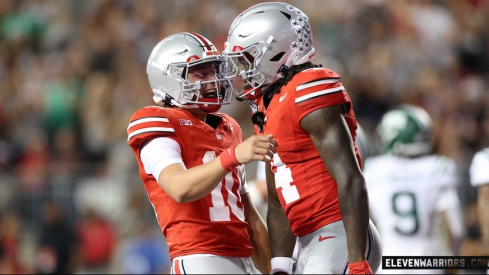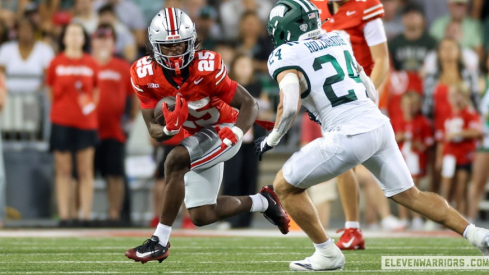 Woody thought sophomores were super
Woody thought sophomores were superThanks again to Cornelius Green for talking to me about his Ohio State playing days, and the years before and after that. In case you missed it last week, you can read Part One here.
In 1973, as he entered his sophomore year at Ohio State, Cornelius Green was named the starting quarterback over senior Greg Hare. Even though Hare, a captain on the team, had guided the Scarlet and Gray to a win against Michigan, a Big Ten title and a Rose Bowl appearance the season before, Woody believed that "Flam" was the best choice to lead his run-heavy offense.
Green felt some of his teammates were unsure about him replacing Hare, recalling, "I had never started a game, so I had to prove to them that I was worthy of playing and I think I did that the first game."
His first start came in the season opener against Minnesota1. The Golden Gophers were no match for the Buckeyes or Green, who guided Ohio State to an easy 56-7 victory. Any doubts his teammates may have had were quickly erased, and the hate mail he had previously received died down as well because as Cornelius puts it, "winning cures all."
And winning is what Ohio State continued to do.
Shutting out four of their nine regular season opponents, the Scarlet and Gray breezed past the competition towards their annual clash with the hated Wolverines. However, in the game prior to that, Green jammed his thumb against Iowa and was limited in practice the week leading up to The Game. It was an especially significant Ohio State vs. Michigan contest for Cornelius, who resented The Team Up North not only because the rivalry demanded it, but also because U of M was one of the few schools that did not try to recruit him.
Also noteworthy about the '73 edition of The Game was that it marked the first time that both of the starting quarterbacks were African-American2. Yet, what mattered to Corny and Dennis Franklin, his Maize and Blue counterpart, was earning the victory. As was often the case, the winner would claim the Big Ten title and a trip to Pasadena while the loser would go home, its season finished. That year, the stakes were even higher because both teams were undefeated.
Headed into Ann Arbor, Ohio State was ranked #1 in the polls; Michigan checked in at #4.
Since Woody did not want to tip off Wolverine coach Bo Schembechler, Green's injury was never reported to the media. During the game, he couldn't wrap it for the same reason, despite not being able to grip the ball correctly. Although Woody primarily used him for his running abilities throughout the season, and each snap was painful as it hit his thumb, Corny still laments that his coach did not let him to throw.
After taking a 10-0 lead at the half, Ohio State allowed Michigan to tie it up in the fourth quarter. Woody then decided to put Hare in at quarterback for a passing situation. The Wolverines picked him off, and with less than 30 seconds remaining on the clock, kicker Mike Lantry missed the potential game-winning field goal attempt. It was his second failed kick of the game, which ended in a 10-10 tie.
The following day, the athletic directors from the other Big Ten schools gathered to vote on which team to send to the Rose Bowl to battle the USC Trojans. In part because Michigan would have been without the services of Dennis Franklin, who broke his collarbone against the Buckeyes, Ohio State received the nod.
On New Year's Day in 1974, Green, his thumb since healed, got his wish to pass the ball. He threw an interception on the first play of the game.
It was only appropriate that Hollywood was mere miles away because Cornelius claims "you couldn't write a script like this" based on what happened next.
After the pick, #7 worried that he wouldn't be allowed to pass anymore. Instead, he earned Rose Bowl MVP honors. Green ended up throwing for 129 yards on 6/8 passing as Ohio State defeated USC, 42-21. With 320 of their 449 yards coming via the run, the Buckeye offense was mostly true to form, but Green's timely throws were pivotal when his team took the lead for good in the third quarter. While Archie Griffin paved the way with 149 yards on the ground and freshman fullback Pete Johnson rushed for three touchdowns, it was the balanced attack from the quarterback that made a bigger impact on the outcome that afternoon.
Cornelius considers that Rose Bowl both his best and most memorable game at Ohio State. At the end of his first year as starting QB, he had played the game of his life, one that he says, "put me on the map, nationally."
Days later, he received a key to his hometown city of Washington, D.C., which celebrated January 4th as "Cornelius Green Day."
Flam knew about celebrations, becoming the first Buckeye to dance in the end zone after he scored a touchdown3. Surprisingly, Woody did not forbid it, even as others followed suit. Nevertheless, while their coach may have allowed them to express themselves, Cornelius clarifies, "we were star players and didn't get star treatment by Coach Hayes."
If not for the tie against Michigan, the only blemish on their record, the '73 Buckeyes could have won a national championship. Still, Green believes they were "one of the greatest teams ever in Ohio State history", a sentiment shared by many others.
 Green felt like passing
Green felt like passingExpectations were high that the '74 team would bring home a national title. Green had yet to lose a game as a starter, and despite his success the season before, he thinks grew the most, knowledge-wise, as a player between his sophomore and junior years.
Then came a controversial meeting with Michigan State, the school Corny eschewed in favor of attending Ohio State. The Buckeyes entered East Lansing with a #1 ranking and an 8-0 record but fell behind 16-13 with a few minutes left in the game. With less than 30 seconds to go and the ball at the half-yard line, fullback Champ Henson headed for the end zone. One referee signaled that the touchdown was good while the other did not.
Without any timeouts remaining, the offense had to hurry up and snap the ball before the clock reached zero. The errant snap was picked up by wingback Brian Baschnagel, who scored the winning touchdown...according to one official. The other said Ohio State didn't get the ball off before time expired. In an era lacking instant replay, the teams were sent to their respective locker rooms to await a final decision.
Over half an hour later, Big Ten Commissioner Wayne Duke delivered the verdict: Michigan State was declared the victor, 16-13. An enraged Coach Hayes had choice words for Duke and his team knew that their national title hopes were dashed.
Cornelius maintains, "they snatched victory from us twice." It would be his only regular season loss as the starting quarterback for the Scarlet and Gray.
Ohio State rebounded to beat Iowa and Michigan, the latter a 12-10 defensive battle that once again ended with Lantry missing what would have been the game-winning field goal.
For the third straight year, Ohio State encountered USC in the Rose Bowl. Green directed the Buckeyes to a touchdown on a fourth quarter drive that gave them a 17-10. However, with two minutes remaining, the Trojans scored a touchdown and then went for two. The two-point conversion worked, and USC won the 1975 Rose Bowl, 18-17.
Although the season was somewhat disappointing as a result of two heartbreakingly close losses, nearly the entire running game was coming back, including Corny and Archie, that year's Heisman Trophy winner.
It was during his senior season that Green would reach his proudest achievement as a Buckeye.
Check back next Friday for the third and final part of this series.
- 1 Whose quarterback was the eventual Super Bowl-winning coach Tony Dungy.
- 2 They would face off once more the following year, but it wasn't until 2010 that both teams started black QBs again, this time with Terrelle Pryor and Denard Robinson.
- 3 Corny's signature move was a Muhammad Ali-esque shuffle.

